Chevrolet Silverado: Vehicle Checks / Cooling System
If the vehicle has the Duramax diesel engine, see the Duramax diesel supplement.
The cooling system allows the engine to maintain the correct working temperature.
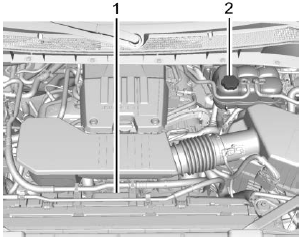
2.7L L4 Engine (L3B)
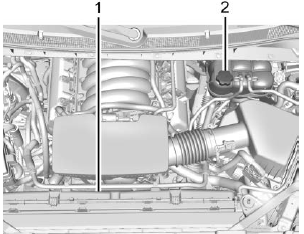
4.3L V6 Engine (LV3)
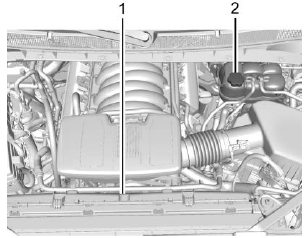
5.3L V8 Engine (L84) Shown, 5.3L
V8 Engine (L82) and 6.2L
V8 Engine (L87) Similar
-
Engine Electric Cooling Fans (Out of View)
-
Coolant Surge Tank and Pressure Cap
Warning
An underhood electric fan can start up even when the engine is not running and can cause injury. Keep hands, clothing, and tools away from any underhood electric fan.
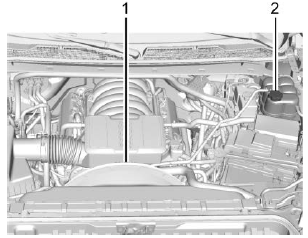
6.6L V8 Engine (L8T)
- Engine Cooling Fan (Out of View)
- Coolant Surge Tank and Pressure Cap
Warning
Do not touch heater, radiator, a/c pipes or hoses, or other engine parts. They can be very hot and can burn you. Do not run the engine if there is a leak; all coolant could leak out. That could cause an engine fire and can burn you. Fix any leak before driving the vehicle.
Engine Coolant
The cooling system in the vehicle is filled with DEX-COOL engine coolant. This coolant is designed to remain in the vehicle for 5 years or 240 000 km (150,000 mi), whichever occurs first.
The following explains the cooling system and how to check and add coolant when it is low. If there is a problem with engine overheating, see Engine Overheating.
What to Use
Warning
Plain water, or other liquids such as alcohol, can boil before the proper coolant mixture will. With plain water or the wrong mixture, the engine could get too hot but there would not be an overheat warning. The engine could catch fire and you or others could be burned.
Use a 50/50 mixture of clean, drinkable water and DEX-COOL coolant. This mixture:
- Gives freezing protection down to −37 °C (−34 °F), outside temperature.
- Gives boiling protection up to 129 °C (265 °F), engine temperature.
- Protects against rust and corrosion.
- Will not damage aluminum parts.
- Helps keep the proper engine temperature.
Caution
Do not use anything other than a mix of DEX-COOL coolant that meets GM Standard GMW3420 and clean, drinkable water. Anything else can cause damage to the engine cooling system and the vehicle, which would not be covered by the vehicle warranty.
Never dispose of engine coolant by putting it in the trash, or by pouring it on the ground, or into sewers, streams, or bodies of water. Have the coolant changed by an authorized service center, familiar with legal requirements regarding used coolant disposal. This will help protect the environment and your health.
Checking Coolant
The coolant surge tank is in the engine compartment on the driver side of the vehicle. See Engine Compartment Overview.
The vehicle must be on a level surface when checking the coolant level.
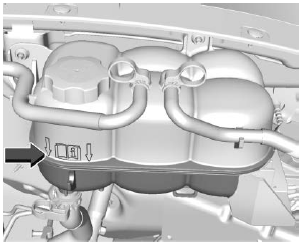
All Engines Except 6.6L V8 (L8T) Engine
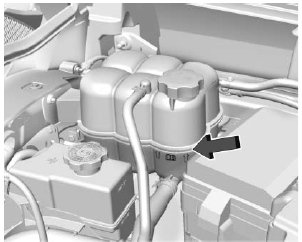
6.6L V8 (L8T) Engine Only
Check to see if coolant is visible in the coolant surge tank. If the coolant inside the coolant surge tank is boiling, wait until it cools down. The coolant level should be at or above the indicated mark. If it is not, there may be a leak in the cooling system.
If coolant is visible but the coolant level is not at or above the indicated mark, see the following sections on how to add coolant to the coolant surge tank following.
Automatic Coolant Service Fill Instructions (L3B Engine)
See 3.0L Duramax Diesel supplement for the diesel engine procedure.
If equipped, this feature assists in filling and removing air from the cooling system after service of components or when coolant is added after being too low.
To activate the fill and air removal process:
- With a cold system, add coolant to the indicated mark on the surge tank.
- Replace the cap on the surge tank.
- Connect the vehicle to a battery charger.
- Set the ignition to Service or Accessory Mode. See Ignition Positions (Keyless Access) or Ignition Positions (Key Access).
- Turn off the air conditioning.
- Set the parking brake.
- At the same time, press the accelerator and the brake for automatic transmission vehicles for two seconds, then release.
At the end of the cycle, check the coolant level in the surge tank and add coolant if it is low. Turn off the vehicle, allow the Electronic Control Module (ECM) to go to sleep, about two minutes, and repeat Steps 3–7.
Listen for pump activation and movement of the control valves while watching the level of the coolant in the surge tank. If the tank empties, turn the ignition off, carefully remove the surge tank cap, refill to the indicated mark, and repeat Steps 3–6. The fill and air removal process will run for approximately 10 minutes.
How to Add Coolant to the Coolant Surge Tank for Gasoline Engines Except L3B
If the vehicle has a diesel engine, see “Cooling System” in the Duramax diesel supplement for the proper coolant fill procedure.
Warning
Spilling coolant on hot engine parts can burn you. Coolant contains ethylene glycol and it will burn if the engine parts are hot enough.
Warning
Plain water, or other liquids such as alcohol, can boil before the proper coolant mixture will. With plain water or the wrong mixture, the engine could get too hot but there would not be an overheat warning. The engine could catch fire and you or others could be burned.
Warning
Steam and scalding liquids from a hot cooling system are under pressure. Turning the pressure cap, even a little, can cause them to come out at high speed and you could be burned. Never turn the cap when the cooling system, including the pressure cap, is hot. Wait for the cooling system and pressure cap to cool.
Caution
Failure to follow the specific coolant fill procedure could cause the engine to overheat and could cause system damage. If coolant is not visible in the surge tank, contact your dealer.
If no coolant is visible in the surge tank, add coolant.
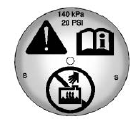
- Remove the coolant surge tank pressure cap when the cooling system, including
the coolant surge tank pressure cap and upper radiator hose, is no longer hot.
Turn the pressure cap slowly counterclockwise about one full turn. If a hiss is heard, wait for that to stop. A hiss means there is still some pressure left.
- Keep turning the pressure cap slowly, and remove it.
- Fill the coolant surge tank with the proper mixture to the full cold mark.
- With the coolant surge tank pressure cap off, start the engine and let it
run until the engine coolant temperature gauge indicates approximately 90 °C
(195 °F).
By this time, the coolant level inside the coolant surge tank may be lower. If the level is lower, add more of the proper mixture to the coolant surge tank until the level reaches the indicated mark.
- Replace the pressure cap tightly.
- Verify coolant level after the engine is shut off and the coolant is cold. If necessary, repeat coolant fill procedure Steps 1–6.
Caution
If the pressure cap is not tightly installed, coolant loss and engine damage may occur. Be sure the cap is properly and tightly secured.
 Engine Air Cleaner/Filter
Engine Air Cleaner/Filter
The engine air cleaner/filter is on the driver side of the engine compartment.
See Engine Compartment Overview.
When to Inspect the Engine Air Cleaner/Filter
If the vehicle is not equipped with the engine air filter life system see Maintenance
Schedule for intervals on inspecting and replacing the engine air cleaner filter...
 Engine Overheating
Engine Overheating
If the vehicle has the Duramax diesel engine, see the Duramax diesel supplement.
Caution
Do not run the engine if there is a leak in the engine cooling system...
Other information:
Chevrolet Silverado 2019-2026 Owners Manual: Folding the Rear Seat Cushion
Either side of the rear seat cushion can be folded up for added cargo space. Caution Folding a rear seat with the seat belts still fastened may cause damage to the seat or the seat belts. Always unbuckle the seat belts and return them to their normal stowed position before folding a rear seat...
Chevrolet Silverado 2019-2026 Owners Manual: Instrument Panel Overview
Tow/Haul Mode (On Some Models). See Driver Mode Control.Automatic Transfer Case Control (If Equipped). See Four-Wheel Drive. Driver Mode Control (If Equipped). Air Vents. Turn Signal Lever. See Turn and Lane-Change Signals.Windshield Wiper/Washer...
Categories
- Manuals Home
- 4th Generation Silverado Owners Manual
- 4th Generation Silverado Service Manual
- Instrument Panel Fuse Block (Left)
- Head-Up Display (HUD)
- Electric Parking Brake
- New on site
- Most important about car
Passenger Sensing System
The vehicle has a passenger sensing system for the front outboard passenger position. The passenger airbag status indicator will light on the overhead console when the vehicle is started.
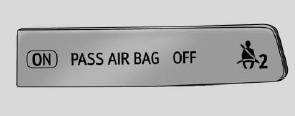
United States
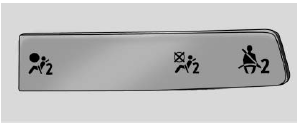
Canada
